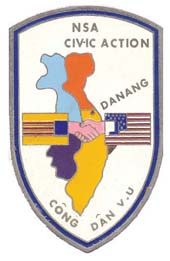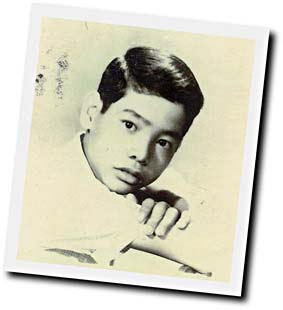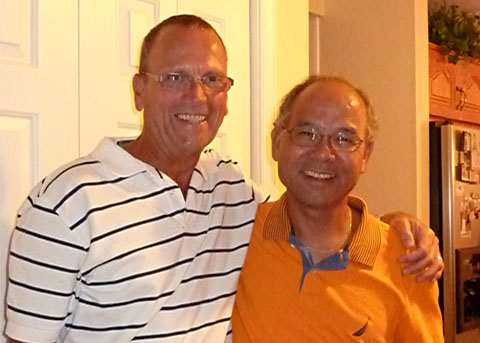 |
|||||||||
|
January/February 2014 Sharing The American Dream BY GEORGE DZYACKY
I was nineteen years old when I landed in country, assigned to Civic Action and moved into Village Assistance Team 3 in the hamlet of Binh Thuan. Civic Action by definition was a U.S. Navy counterinsurgency tool—a weapon of war. In practice, it was more like the military version of the Peace Corps. Our mission was to live with the people in their villages and provide them with medical assistance and building materials to improve the quality of their lives in simple ways. In other words, to win their hearts and minds. Young Nguyen was a precocious thirteen-year-old who used his charm and broken English to latch onto three sailors in need of an interpreter. Unsuspectingly, through my pictures and stories of home, my audiotapes, and my photographs of my fiancée Susan, I was inspiring the impressionable adolescent to dream of a life for himself in the U.S.
Every so often I would see Young’s picture among my Vietnam memorabilia and wonder what ever became of him. Anyone suspected of being a friend of the Americans would have been “reeducated” at best or executed at worst. But time after time I put aside my thoughts of Vietnam. On January 14, 2003, the phone rang. It was Young. He found me. He had been searching since 1975. That year he and his ten-year-old sister had arrived in the U.S. after a harrowing escape out of Da Nang, through the fall of Saigon, a commandeered fishing boat, a sea rescue by an American cargo ship, an Arkansas refugee camp, and eventually to a loving family in rural Virginia. They had been adopted by a retired Vietnam veteran Army surgeon and his wife who had ten children of their own. Young immediately set out to build a new life, locate and marry his childhood sweetheart (who also had immigrated to the U.S.), and find the sailor who befriended him when his world was falling to pieces.
After our families met and I learned all that Young had endured to fulfill his American Dream, I was committed to tell our story. In a 2007 interview Young was asked why he spent so many years looking for the sailor whom he met in 1968. “When I was a boy,” Young said, “George cared about me. He was kind to me. He was nice to me. George treated me like his little brother. I’ll never forget what he did for me.” The emptiness and disillusion of the war that I had felt for so long has vanished. I no longer have to put aside thoughts of Vietnam; the word now rings pleasantly in my ear. I love that Young has achieved an American Dream that I helped inspire, and I especially love that he calls me “brother.”
|
|||||||||
|
|
|||||||||
8719 Colesville Road, Suite 100, Silver Spring. MD 20910 | www.vva.org | contact us |
|||||||||









 I served with the U.S. Navy Civic Action program in Da Nang between August ’68 and December ’69. I was positively naïve about the politics of the Vietnam War. It seemed everyone in my blue-collar neighborhood of Gary, Indiana, believed what we were told about the Domino Theory and the need to prevent the spread of communism in Asia. My grandfather fought in World War I, my father and all five uncles in World War II. I was up; it was my turn at bat. Having been programmed by ancestral expectations to serve my country, I enlisted.
I served with the U.S. Navy Civic Action program in Da Nang between August ’68 and December ’69. I was positively naïve about the politics of the Vietnam War. It seemed everyone in my blue-collar neighborhood of Gary, Indiana, believed what we were told about the Domino Theory and the need to prevent the spread of communism in Asia. My grandfather fought in World War I, my father and all five uncles in World War II. I was up; it was my turn at bat. Having been programmed by ancestral expectations to serve my country, I enlisted.  I turned twenty, then twenty-one in Vietnam and eventually became a short-timer. Over that sixteen months Young and I grew to be good friends. But then my tour ended, and I returned to The World. On the eighteen-hour plane ride home, I rehearsed all my stories of VAT 3 and Young. But when I got home, no one wanted to hear about Vietnam. No one—except for Susan and her college roommate Ann.
I turned twenty, then twenty-one in Vietnam and eventually became a short-timer. Over that sixteen months Young and I grew to be good friends. But then my tour ended, and I returned to The World. On the eighteen-hour plane ride home, I rehearsed all my stories of VAT 3 and Young. But when I got home, no one wanted to hear about Vietnam. No one—except for Susan and her college roommate Ann. Unknown to me, for three decades I was being searched for. Vietnam was looking for me.
Unknown to me, for three decades I was being searched for. Vietnam was looking for me.